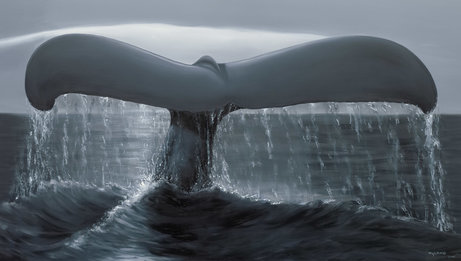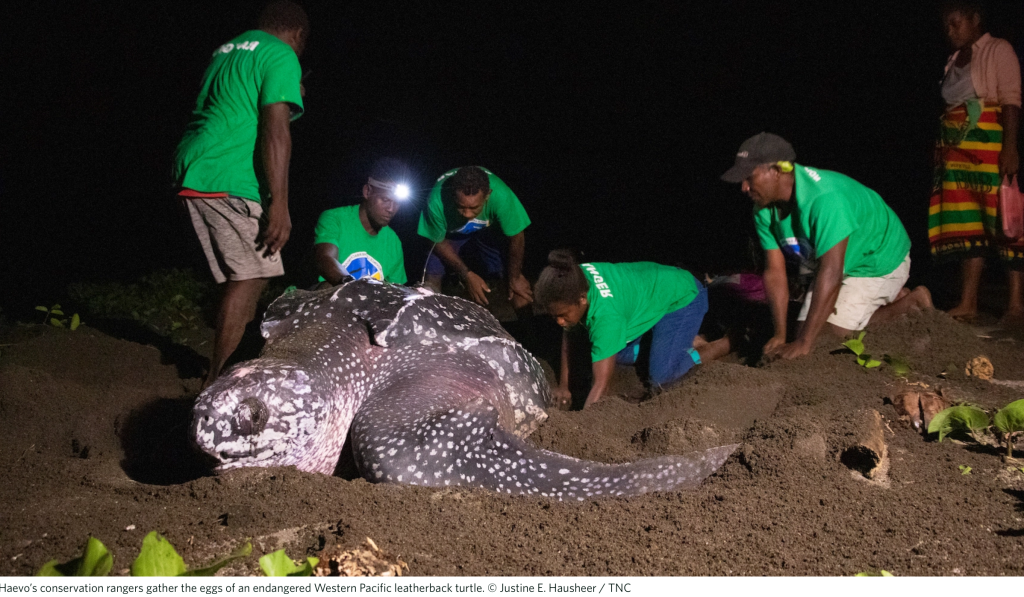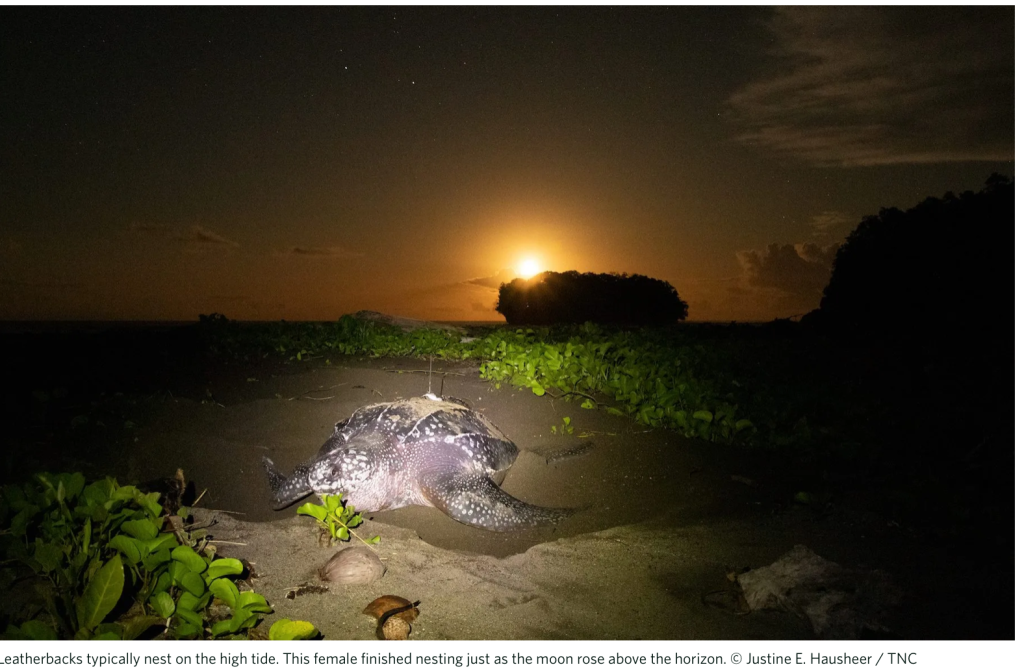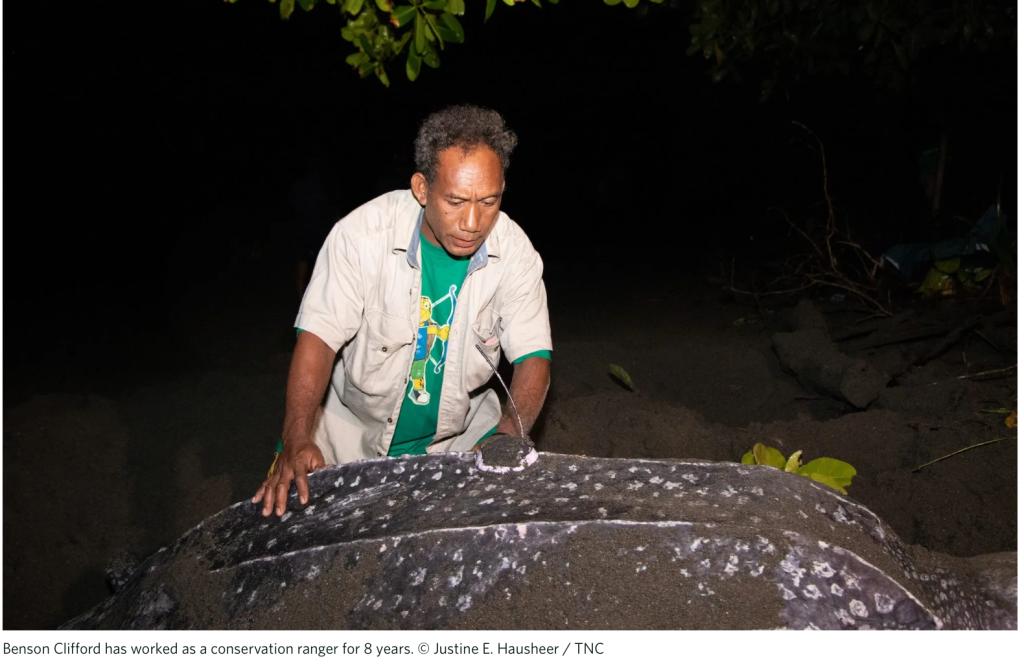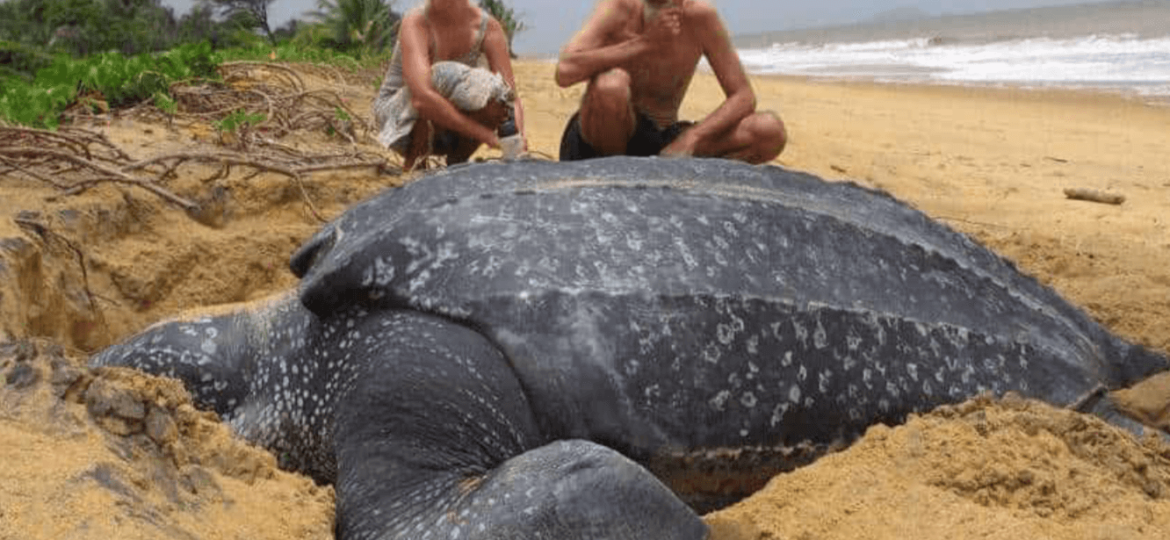
Satellite Tracking the Pacific’s Most Endangered Leatherback Turtles
A new satellite tagging study in the Solomon Islands will guide conservation efforts for the critically endangered Western Pacific leatherbacks. The post Satellite Tracking the Pacific’s Most Endangered Leatherback Turtles appeared first on Cool Green Science. Special thanks to the Nature Conservancy.
“Turtle coming up, turtle coming up. Sector 25.”
I’m sitting on a driftwood log, watching waves crash against the moonlit shore when the walkie-talkie crackles. It’s just after 9:30 pm; we’ve only just started our shift patrolling the beach for nesting leatherback sea turtles, and the call comes sooner than we expected.
Rick Hamilton, director of The Nature Conservancy’s Melanesia program, grabs the walkie-talkie. We wait, holding our breath with anticipation. “New turtle!” shouts an excited voice through the radio. “Hurry, she’s already digging.”
We hurtle back to the thatch shelter to grab our bags. Mine full of camera gear, Hamilton’s holding a work light and three satellite tags cradled in an old shirt. And then we run.
Our feet sink into the soft black sand, waves slapping against our shins as we search for stable footing on the sloping beach. Lights will spook the turtle, so we run in darkness, navigating around massive driftwood logs and stumbling over vines and coconuts.
Just when I think I can’t run any farther, I see a thick, dark line perpendicular to the waves. Another log? No. It’s where the turtle crawled ashore, leaving behind a wide, deep track, like the tread of a monster truck. We’re here.
The other rangers are waiting in the forest’s shadows, all gazing intently at the massive lump against the tree line. We join them, gulping for air and dripping sweat. From the darkness I hear flippers thwack against palm fronds, the swoosh of sand spraying, a soft snort.
A ranger creeps forward, quickly shining a red-light torch to check her progress. The narrow beam illuminates her backside, flippers scooping sand out of a deep, narrow chamber. “She’s ready!” a voice whispers.
We flip on our headlamps, throw down our bags, and then chaos ensues.
Nature Conservancy scientists are working hand in hand with conservation rangers from Haevo community, in the Solomon Islands, to attach 10 satellite tags to nesting leatherback sea turtles. The data they gather will help protect some of the most important nesting beaches for these critically endangered turtles, and reveal their migration routes across entire oceans.
Last Chance for Leatherbacks
My first encounter with a leatherback came just a few days earlier, at the beginning of our week-long stint at Haevo. She crawled up from the sea just before moonrise, digging her nest amidst a tangle of vines on the high dune.
A tape measure stretched across her carapace reads nearly 6 feet long, and her front flippers extended another 2.5 feet on either side. Hard and rigid as airplane wings, those flippers enable her to swim at speeds faster than a bottlenose dolphin, or to dive to depths of nearly 4,000 feet on a single breath. She spends most of her life in the open ocean, feeding on jellyfish far from shore.
Leatherbacks’ evolutionary origins stretch back more than 100 million years, but in the past few decades their populations have declined dramatically. The turtles in the Western Pacific are amongst the hardest hit. Scientists estimate that this genetically distinct subpopulation is now critically endangered, having declined 83 percent in just three generations. Only 1,400 breeding adults are thought to survive, and the population is still falling.
By 2040, scientists predict that the Western Pacific leatherbacks will be whittled down to just 100 nesting pairs each year. “They’re crashing hard, and it’s going to continue unless we arrest the decline,” says Peter Waldie, acting director of TNC’s Solomon Islands program.
Western Pacific leatherbacks nest across Indonesia, especially West Papua’s Bird’s Head Peninsula, Papua New Guinea, and the Solomon Islands. In the Solomons, they concentrate at just a handful of key nesting beaches, including the 2-mile stretch of black volcanic sand known as Haevo.
It’s just one beach, but what happens here could tip the balance for the entire population of Western Pacific leatherbacks.
A Night on Patrol
Earlier that evening, the rangers start work at sunset. A dozen men and women dash about the thatch-roofed hut, changing into their bright green work uniforms, brushing teeth, and gulping down the last of their rice-and-tuna dinner as some indistinguishable local pop music plays on the radio. The plastic folding tables are scattered with charging flashlights and two-way radios, spare pens and data sheets, and thermoses of instant coffee and tea… everything we need for a night’s work on the beach.
As we get ready, I ask the rangers what Haevo was like before the conservation work started.
“During the nesting season, the men from the village would come to the beach and wait,” says Benson Clifford, who has worked as a ranger here for eight years. “When the leatherbacks came ashore, they would kill them and share the meat with the entire village.”
Sea turtles are a traditional food source for Solomon Islanders, typically eaten on special occasions like weddings, birthdays, or funerals. (When Hamilton and I journey to Haevo on an overnight local ferry, the boat captain announced that the ship rules included: no smoking, no drinking, no drugs, and no live turtles.)
In the past few decades, human population growth has increased the hunting pressure to unsustainable levels. Combined with other threats, like entanglement in longline fisheries and rising seas washing away nesting beaches, the pressure is pushing leatherbacks over the brink.
“You don’t have to be a rocket scientist to realize that if you kill all the turtles on a nesting beach, you’re in trouble,” says Hamilton. “These animals migrate across entire oceans, but when they come here to nest, it’s a critical, life-stage bottleneck. That gives us a real opportunity to protect them when it matters most.”
“You don’t have to be a rocket scientist to realize that if you kill all the turtles on a nesting beach, you’re in trouble.”
Richard Hamilton
Leatherbacks are the only turtle species completely protected under Solomon Islands law, but the rangers tell me that most people aren’t aware of the rules and enforcement is nonexistent. Few, if any, of the rangers here knew it was illegal to kill a leatherback until the monitoring program started.
Other turtle species can be hunted for subsistence, not sale, but they can’t be killed while on the nesting beaches. In reality, both rules are almost never enforced. A previous TNC study surveyed local markets for turtle products, finding thousands of turtles for sale.
“All of the turtles that came up to nest would die,” says Clifford. “And they kept killing nesting leatherbacks right up until 2013.” That was the year that TNC started a leatherback monitoring program at Haevo.
It’s fully dark by the time we leave. Slipping off our shoes, we walk along the edge of the waves. Our destination is the ranger station at far end of the beach, which curves gently around a small bay to the mouth of a crocodile-filled river. The black sand still radiates the sun’s warmth, and banks of steam envelop us as we trudge.
We arrive 30 minutes later. The rangers disperse in groups of two and three, each taking up their vigil on a different section of beach. Hamilton and I stay just outside of the camp, watching shooting stars streak across the sky and scanning our section of beach for any movement.
The rangers make this trek each and every night, watching over the beach and recording data on any turtles that come up to nest. Similar monitoring programs are underway at Sosoilo, an hour’s boat ride north of Haevo, and at Sasakolo, on the island’s western side.
Hamilton says that the leatherback work is modeled off of similar work in the Arnavons, where TNC has worked with local communities for nearly three decades to protect a critical rookery for hawksbill sea turtles. Nesting numbers there have more than doubled in the past 20 years, and the Arnavons was recently named the first marine national park in the country.
“>
